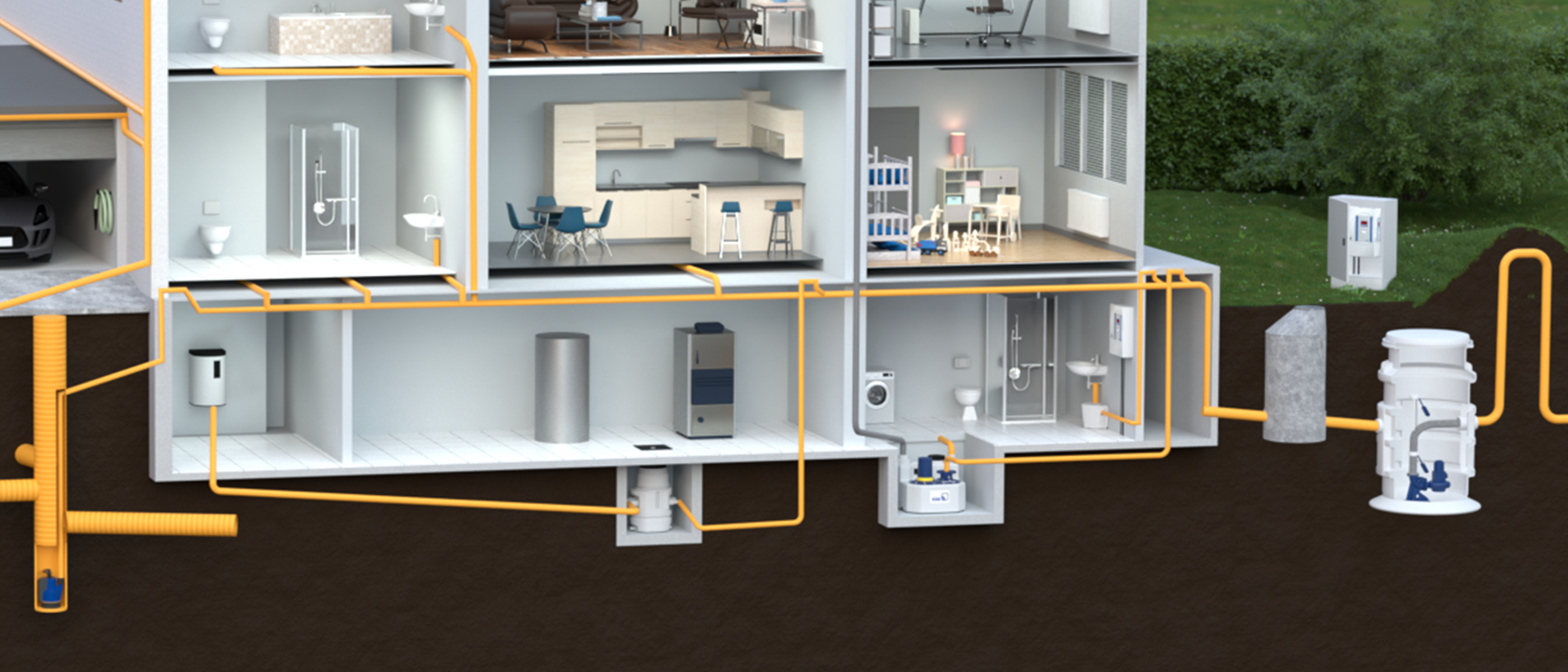
Correctly measuring the fill level in the pump sump
What exactly is a pump sump? And what is its role in the drainage of buildings?
What goes in must come out
As can be seen from the illustration, the pump installed on the pump sump floor transports the waste water above the flood level, from where it is drained into the sewer system by gravity flow.
Various principles of fill level measurement
Measurement with float switches
Draining via float switches. Here at the example of a dual-pump station with two float switches. The pump that is started up first is the base load pump. To ensure equal distribution of pump operating hours, the pumps are automatically alternated after each pumping cycle.
A = Base load float switch
B = Peak load float switch
C = High water float switch (optional)
1 = Both pumps OFF
2 = Base load pump ON
3 = Both pumps ON
4 = High water alert
Measurement with float switches without use of hysteresis
Draining via float switches without use of hysteresis.Example of a single-pump station with draining via two float switches without hysteresis
A = Float switch OFF
B = Base load float switch
C = High water float switch (optional)
1 = Pump OFF
2 = Pump ON
3 = High water alert
Measurement with float switches without use of hysteresis
Draining via float switches without use of hysteresis. Example of a single-pump station with draining via two float switches without hysteresis
A = Float switch OFF
B = Base load float switch
C = High water float switch (optional)
1 = Pump OFF
2 = Pump ON
3 = High water alert
Hydrostatic fill level measurement via pneumatic measurement or bubbler control
Schematic of a pump installed in a pump sump. Level measurement via pneumatic measurement or bubbler control. The additional float switch for high water alert is optional.
A = User-defined switching levels in mm
B = Reference point for level measurement
C = Redundant high water float switch (optional)
1 = Pump OFF
2 = Pump ON
3 = High water alert
Analog level measurement with a level probe
Schematic of a pump installed in a pump sump. The fill level is measured with a 4...20 mA immersion probe. The additional float switch for high water alert is optional.
A = User-defined switching levels in mm
B = Analog IN
C = +24 V
D = Ground (GND)
E = Redundant high water float switch (optional)
1 = Fill level at 4 mA
2 = Pump OFF
3 = Pump ON
4 = High water alert
5 = Level at 20 mA
Conclusion
Suitable products
AmaDrainer 4 / 5/AmaDrainer 80 / 100
AmaDrainer 4../5..: Vertical single-stage fully floodable submersible motor pump in close-coupled design, IP68, with or without level control, max. immersion depth: 7 m. AmaDrainer 80/100: Vertical single-stage fully floodable submersible motor pump in close-coupled design, IP68, with or without level control, max. immersion depth: 10 m.
AmaDrainer Box/AmaDrainer Box Mini
AmaDrainer Box:Stable above-floor plastic collecting tank or impact-resistant underfloor plastic collecting tank, with floor drain and odour trap, both with AmaDrainer submersible motor pump starting and stopping automatically and swing check valve AmaDrainer Box Mini:Reliable and compact grey water lifting unit in a modern design with activated carbon filter meeting hygiene requirements and with shower connection as standard; complies with EN 12050-2.
Compacta
Floodable single-pump sewage lifting unit or dual-pump sewage lifting unit for automatic disposal of waste water and faeces in buildings and building sections below the flood level.
MiniCompacta
Floodable single-pump sewage lifting unit or dual-pump sewage lifting unit for automatic disposal of domestic waste water and faeces in building sections below the flood level.
LevelControl Basic 2
Level control unit for controlling and protecting either one or two pumps. DOL starting up to 4 kW, star-delta starting up to 30 kW. Higher ratings on request.